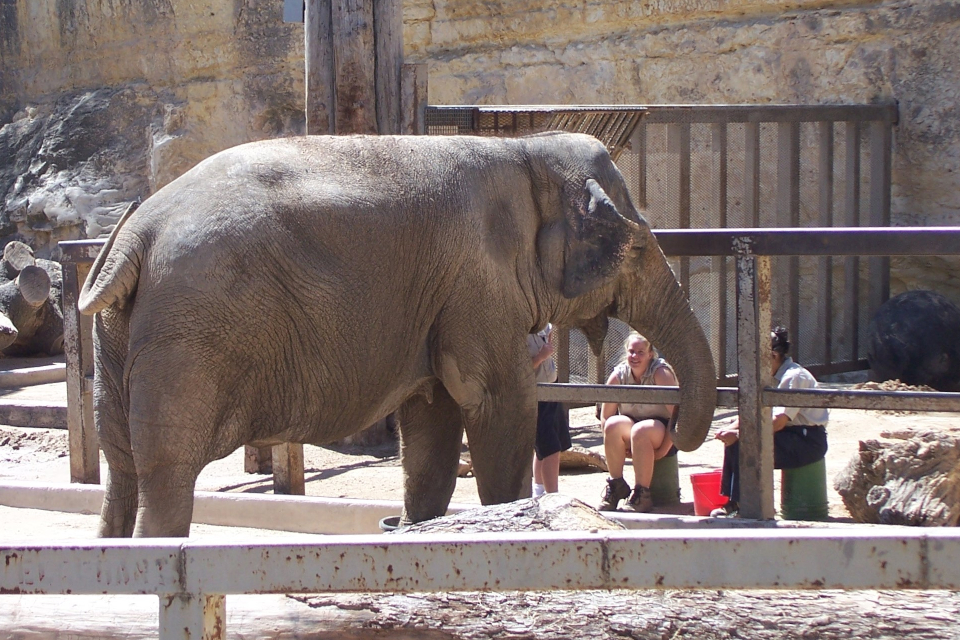Exclusively for zoos.media – 10.05.2023. Author: Philipp J. Kroiß
A geriatric female elephant was transferred from an accredited zoo to an animal rights industry sanctuary. She survived the transfer for only a few weeks.
Zoo elephant survives only a few weeks in sanctuary
The greatest danger for the zoo world itself, but also for the people and animals that live in it, is probably the opportunism of certain zoo associations. Not only does it cost credibility, but it costs lives. Nichole, also known as Nicole or Nicky, was a female elephant who had lived at the San Antonio Zoo in Texas since 2016. She had come to the United States in 1980 because Ringling Bros. and Barnum and Bailey bought the animal, born in 1975, from a lumber business. In Myanmar, where she came from, it’s normal to keep elephants as livestock, much like horses in Europe, for example, – even in the timber trade.
Dubious cooperation
The largest – not the only, mind you – zoo association in North America, and expanding beyond, AZA, has already been increasingly open to the animal rights industry. Part of this “policy of addition” was the certification of the animal cruelty husbandry “The Elephant Sanctuary” (TES). It was and is known for exceptionally poor husbandry of elephants far below the standards of modern zoos. It was founded several years ago by Carol Buckley. Sadly, it joins the ranks of animal cruelty holding facilities that the animal rights industry greenwashes through its own Global Federation of Animal Sanctuaries (GFAS) accreditation.
How many more elephants? Paws and TN elephant sanctuary have had numerous deaths pic.twitter.com/lcaIWHW5QD
— Felicia Frisco (@teentigermom) July 24, 2015
What characterises these sanctuaries that we have been warned about for years? TES used to be a no-contact (NC) sanctuary, and now they boast of a protected-contact (PC) sanctuary, as do all AZA members. The problem with this protected contact is that it requires the cooperation of the animal. This in itself is a minor problem if there’s a good relationship with the trainer, so that even in case of illness the animal still comes to the grid and can be treated. However, in any case, the management in free contact (FC) is safer in such a case. Therefore, the AZA is rightly criticized for categorically rejecting free contact with all its advantages.
Clear mistakes with Nicky
At the San Antonio Zoo, Nicky’s long-time companions Karen and Lucky had passed away. Therefore, the decision was made to move the old elephant cow to the TES – or rather to deport her. The old animal was probably no longer needed, because keeping her would have simply prevented the conversion of the elephant facility. For a transitional period, the elephants’ “subsequent tenants” were Bactrian camels, also known as “Golden Girls”. At this time, Nicky was already chronically foot-sick and suffered from bone marrow inflammation.
Putting them in a foreign husbandry with this clinical diagnosis is problematic in itself. Foot care is not only much more elaborate in PC, but it also takes more time. It is foreseeable that in a new environment, a chronically footsore elephant will not really have much motivation to let strangers treat its sick feet. In addition, of course, there is the poor management of the TES and the lack of successful experience with special care animals.
Deported to die?

It was little surprise that such an elephant would not last long in such a “sanctuary” as the TES. A geriatric animal needs intensive care from proven experts. At the San Antonio Zoo or any other modern zoo, she had that and would have continued to have it. At the TES, the chance of her receiving the appropriate care can only euphemistically be described as “slight.” The condition must have rapidly deteriorated or already the transport might have taken place under questionable conditions.
On April 20, 2023, just over a month after her transport, Nicky could no longer stand on her feet and had to be euthanized. At least that is what TES reports. They further claim that the cause was the severe foot disease, advanced degenerative joint disease and a large abdominal tumor. Necropsy results are to be expected. However, whether one can ever expect serious results is questionable, the TES has always been good at sweeping its own failure under the rug.
The bigger question is: Was this the plan from the beginning? You give an old, sick animal to an institution that is not known for animals surviving long in its care. After all, two-thirds of the animals admitted so far have already died, although the sanctuary is not even that old. A zoo with such a record would have long been publicly pilloried by the animal rights industry. You don’t bring an animal to institutions like TES so that it lives. Similar motives can be seen in the case of Lolita.
A remarkable record
If we look at how long animals survive in TES, it is remarkably short.
- Delhi (1946-2008) – about 5 years
- Shirley (1948-2021) – about 22 years
- Lota (1951-2005) – less than 0.5 years
- Bunny (1952-2009) – about 10 years
- Liz (1957-2015) – about 9 years
- Queenie (1959-2008) – about 5 years
- Dulary (1963-2013) – about 6 years
- Misty (1963-2016) – about 12 years
- Lottie (1965-2010) – about 4 years
- Barbara (1966-2001) – about 5 years
- Frieda (1966-2015) – about 9 years
- Winkie (1966-2017) – about 17 years
- Rosie (1969-2016) – about 1 year
- Tina (1970-2004) – about 1 year
- Jenny (1972-2006) – about 10 years
- Nichole (1975-2023) – less than 0.5 years
- Zula (1975-2009) – about 5 years
- Hadari (1980-2017) – about 2 years
- Ned (1987-2009) – about 0.5 years
Thus, one can assume – roughly calculated – about 6 years life expectancy at TES on average. Measured against the allegedly – but of course not actually – much better keeping conditions than in the zoo or circus, this is frighteningly little, even if we consider that they typically care for older animals. But the list also shows very clearly that even younger animals don’t have significantly higher chances of survival. The animals from the 1970s and 1980s survived on average only about 3 years in the TES and thus even less than the overall average.
A pact with death

Whoever brings elephants to this sanctuary does not intend for them to have a long, beautiful life. It is very clear that their demise is brought about as quickly as possible. They want to get rid of them and the animal rights industry provides this “service” as they are just incompetent enough for the animals not to survive for too long. The fact that the AZA certifies this and also applauds member zoos for operating this way harms all members of the association. Above all, it devalues any accreditation and certification that has been carried out.
Whoever wants to keep elephants in zoos assumes a responsibility for an exceptionally long life. To deport animals in their old age to animal cruelty sanctuaries in order to get rid of them as quickly and easily as possible is undignified for all involved. The Knoxville Zoo is also in the process of transferring its elephants to the TES. They will probably not be granted a long life if the trend continues. The animals are in their late 30s to mid-40s, so it is unlikely and could only be attributed to luck that they will live to see 50.
Deafening silence
According to PETA, elephants can live up to 70 years. The actual life expectancies, however, look different. The fact that this, which the animal rights industry demands of zoological gardens, has not even succeeded in the TES among about 30 animals, however, suddenly no longer seems to bother animal rights activists. It’s not like they have not taken in animals that had the chance to be 70 today. But they couldn’t even keep Lota, for example, alive for a year. Yet when that happens, the animal rights industry is pretty quiet. Animals like Lota, Nicky and other elephants are obviously not isolated cases.
But not only the animal rights industry is silent, so is the rest of the zoo world. The AZA, which boasts of oh-so-high animal welfare standards, seems to have a problem with holding the animal rights industry, which it is just shamelessly chumming up to, accountable for its lack of animal welfare. Of course, the TES is not only greenwashed by the animal rights industry but also by the AZA through this completely ridiculous certification. For years we have heard from the AZA that they want to eliminate lousy animal husbandry: thus, not only private owners are attacked but also zoological gardens not accredited by the AZA. Most recently, however, they got a bloody nose from Pittsburgh Zoo:
